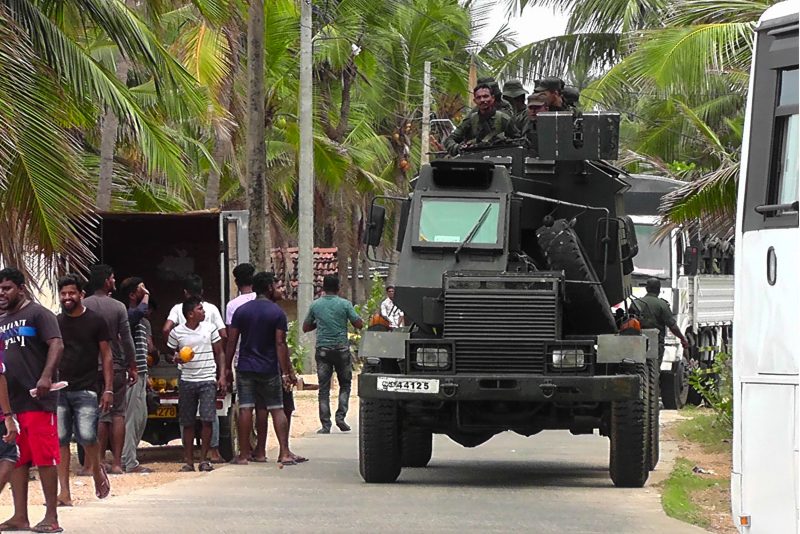What we know about the Sri Lanka bombers
Soldiers patrol in Kalmunai where three suicide bombers blew themselves up during a raid by troops and police on Friday (STR)
Colombo (AFP) – Sri Lanka’s horrific Easter attacks that killed 253 people were orchestrated by a firebrand cleric who sought out young men from wealthy families and radicalised them into suicide bombers, according to initial evidence gathered by investigators.
Here is what we know about the men suspected of carrying out the deadliest single-day massacre of civilians in the island’s history.
– Who was the ringleader? –
The attacks were led by Zahran Hashim, a Sri Lankan Muslim preacher who founded the radical National Thowheeth Jama’ath (NTJ) organisation in the eastern town of Kattankudy.
After Hashim’s violent diatribes sparked a police investigation in 2017, he fled the town, disappearing for years until he resurfaced as one of the two suicide bombers who killed dozens at Colombo’s luxury Shangri-La hotel on Easter Sunday.
Military sources said Hashim was not known to have visited Syria or Iraq, but had travelled to Tamil Nadu state in southern India and been in contact with Islamists there.
Sri Lankan authorities had received a tip-off about the attacks from India intelligence services, which reportedly obtained the information from an Islamist in custody in Tamil Nadu.
Hashim also appeared in a video released by the Islamic State group, showing him leading others in pledging allegiance to IS chief Abu Bakr al-Baghdadi. IS has claimed responsibility for the Sri Lanka attacks.
– Who were the other bombers? –
Hashim’s accomplice was a wealthy local spice trader, Ilham Ibrahim, who carried out a simultaneous blast at the hotel, according to a military analysis of CCTV footage from the Shangri-La.
Ilham’s older brother Inshaf Ahmed attacked a restaurant inside the five-star Cinnamon Grand hotel.
The two brothers were set to inherit Ishana Exports, a lucrative spice business founded by their father, and had reportedly willed their property worth millions of rupees to other relatives just before the massacre.
The man who blew up a restaurant in the luxury Kingsbury hotel is yet to be named by police, while a fifth bomber, who bungled an attack on another Colombo hotel, has been identified by local community leaders as Abdul Latheef.
Latheef, who detonated his device hours later, had studied engineering at London’s Kingston University and pursued postgraduate studies in Australia.
A sixth bomber who struck the evangelical Zion church in the eastern town of Batticaloa was reportedly living in nearby Kattankudy. But locals told AFP he was not known to the community.
Police have not released any details about the remaining bombers who attacked two churches in Colombo and the nearby town of Negombo.
– How were the bombers radicalised? –
Police are trying to piece together how so many successful young men raised in relative comfort in Colombo established intimate ties with a fundamentalist cleric who was disliked by moderate Muslims in his home town.
“We have no idea how they were brainwashed,” a member of Sri Lanka’s Spice Council told AFP, referring to the sibling hotel attackers. “They were seen as a very respectable family.”
Investigators say that access to the wealth owned by some of his young acolytes allowed Hashim to finance militant activities and acquire more followers.
– Did the bombers’ families support them? –
In some cases, yes. When police raided the plush family home of the hotel attackers in Colombo hours after the blasts, the pregnant wife of one of the brothers detonated a bomb, killing herself, her two children and two policemen.
Another relative also blew himself up, killing a police inspector.
“The other family members knew what the brothers were up to,” a senior police officer said. “It was as if they knew we were coming and they were prepared to blast themselves.”
The remaining family members, including the father of the two men, are in custody.
Police said three other suicide bombers who blew themselves up in the east of the country during a security raid on Friday were believed to be relatives of Hashim, pending DNA tests.
The three men who died on Friday had earlier posted a video on social media, saying the widows of three of the Easter attackers would soon join their husbands in heaven.
Police found the charred and mutilated bodies of the three suicide bombers along with those of three women. Six children were also killed in the explosions.
Three other men were shot dead during clashes with police, while one woman and a child were injured. Police say the surviving woman was Hashim’s widow and the injured four-year-old girl his daughter.
– What about the rest of Hashim’s followers? –
Just over 150 suspects have been arrested in a week of intense cordon-and-search operations across the country, but it is not clear if all of them were directly linked to Hashim’s group which was outlawed on Saturday.
Sri Lankan President Maithripala Sirisena said about 140 people loyal to Hashim may still be walking free.
The authorities are not ruling out the possibility of the existence of other as yet dormant jihadist cells in the country.
Before the Easter attacks the NTJ’s only major act of violence dated back to December when two of their members were arrested in the central town of Mawanella for desecrating Buddha statues.
Disclaimer: Validity of the above story is for 7 Days from original date of publishing. Source: AFP.


